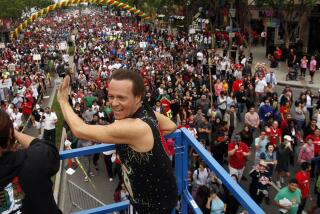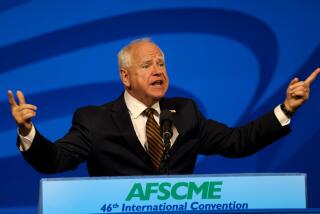Roy Simmons dies at 57; NFL player later came out as gay
The ability to disguise is valued in football, as it is essential to fooling an opponent.
In a sense, offensive lineman Roy Simmons was better at concealing than most.
Simmons hid his homosexuality from his New York Giants and Washington Redskins teammates throughout his career, and in retirement became the second NFL player to announce that he was gay.
“If Roy had come out when he was a player, he would have been accepted,” former Giants teammate Harry Carson said last week. “He would have been fine. I can state that emphatically because I was a captain and we had strong leadership in the locker room.”
Simmons, who had been hospitalized in New York in recent months for pneumonia, died Feb. 20 in his apartment in the Bronx, said longtime friend James Hester. Simmons was 57.
Known as “Sugar Bear” for his huge build and gentle personality, Simmons was the only player in NFL history to acknowledge he was HIV positive. He revealed in his autobiography that he had been raped as a child in Savannah, Ga., and after his playing career struggled with heavy drinking, drug use and sexual promiscuity with both men and women.
“I believe that with his closeted life in the NFL, combined with trying to be honest and reaching out and wanting to be someone in the world, the doors just kept getting slammed in his face,” said Hester, who co-wrote Simmons’ 2006 autobiography, “Out of Bounds.”
“And what did it lead him back to? Destruction. And destruction led to death.”
The 6-foot-3, 260-pound Simmons, who played college football at Georgia Tech, entered the NFL in 1979 and played guard for the Giants. Although he wasn’t a high-profile player, the Giants coach at the time, Ray Perkins, said Simmons “just might be the best athlete on this football team.”
Simmons’ career with the Giants was short-lived, however, lasting just three seasons. After sitting out a year, he joined the Redskins for the 1983 season, making it to the Super Bowl as a backup lineman. His final game in the NFL was that defeat to the Los Angeles Raiders. The Redskins released him before the 1984 season.
In his book, Simmons said he and fellow Redskins often free-based cocaine together, and he admitted to using cocaine the night before the Super Bowl. After one season in the United States Football League, his playing career ended. He moved to San Francisco, where he was frequently homeless, said he made money as a prostitute and once knifed a man during a back-alley drug deal.
Simmons revealed his homosexuality on Phil Donahue’s talk show in 1992, joining Dave Kopay, then the only former NFL player to have announced that he was gay.
“In the NFL, there is nothing worse than being gay,” Simmons told the New York Daily News in 2006. “You can beat your wife, but you better not be gay.”
The topic has been especially relevant in the NFL recently, as star Missouri defensive end Michael Sam announced last month that he is homosexual, putting him on track to become the NFL’s first openly gay player when he is drafted in May.
Simmons was aware of Sam’s situation and pleased to have played a part in paving the way for gay players in the NFL, Hester said, but was hurt that neither Sam nor his representatives acknowledged him or his contribution to the cause.
Born on Nov. 8, 1956, in Savannah, Roy Franklin Simmons was the second of six children — five boys and a girl — and was raised in an impoverished single-parent household. He was giving and kind-hearted, said his younger brother Gary, and always participating in community service.
“He was more of a father to us than an older brother,” said Gary Simmons, 42.
When he was selected by the Giants in the eighth round of the 1979 draft, signing a contract that paid him about $100,000 per year, Roy Simmons moved his three youngest brothers into his home in Rutherford, N.J., wanting to provide them with a better life.
“He didn’t want us to live in the South in poverty,” Gary Simmons said. “It was his way of making sure we attained a proper education. He was very concerned about how we were, and he didn’t want us to go through some of the things he went through. He was always there for our mom, our cousins.”
The younger Simmons said his brother was haunted throughout his adult life by being sexually assaulted as a child by a respected adult, one who was never prosecuted.
“That probably stole his childhood,” he said. “It was not addressed. I learned of it by hearing him tell his story when he wrote his book. It’s horrific going through life trying to hide that pain. You don’t want that story to get out, so you hold on to it. But at the same time it’s eating you up inside. That shows you what kind of strong person he was.”
Hester said he has reached out to the NFL, the NFL Players Assn., the Giants and others in hopes of raising money so that Roy Simmons might be buried in Savannah.
Simmons is survived by his daughter Kara Jackson; sister Catherine; brothers Larry, Ricky, Latwan and Gary; and a grandson.
More to Read
Start your day right
Sign up for Essential California for the L.A. Times biggest news, features and recommendations in your inbox six days a week.
You may occasionally receive promotional content from the Los Angeles Times.







